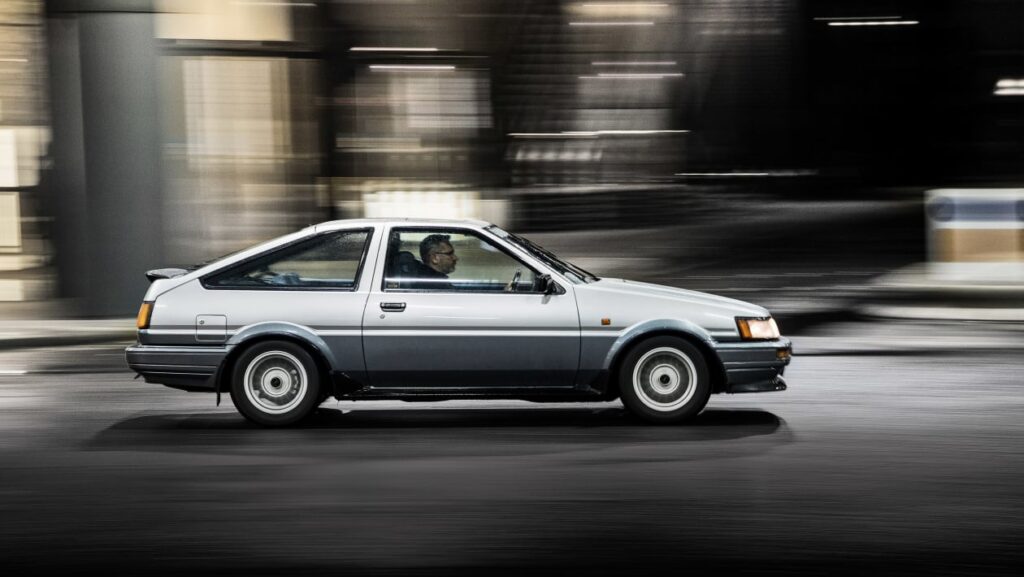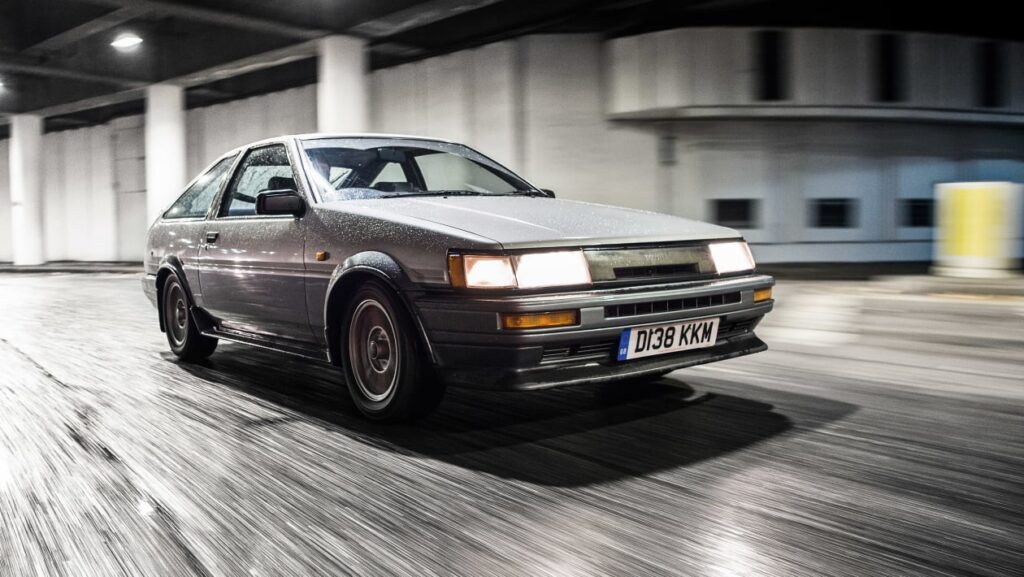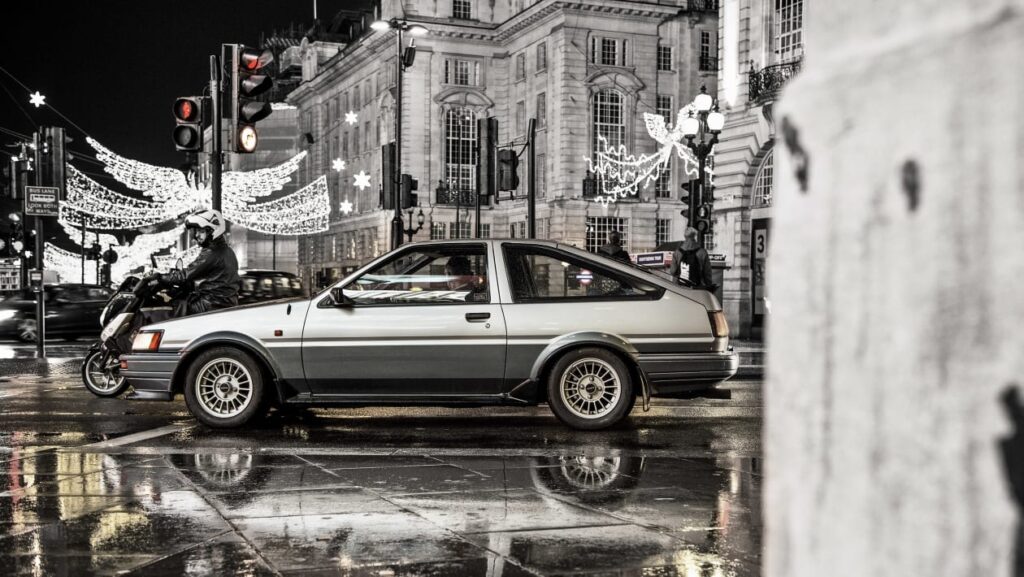Every skilled craftsman has a favourite tool. What might seem like any regular hammer or a chisel or even a pencil for that matter, in their hands is what carves their vision into reality. Character and life flow from their hands through the tool (the medium) into their product. You and, we fail to see the significance of that instrument. However, it is an extension of them, an excuse to work more and more on their beloved craft. Have you had a similar experience? An item, any item really, which under your possession, put in simple words, made you feel nearly invincible and limitless? I’m guessing for the sake of this story and me, you would have to.
Such was the relationship between a passionate driver and his Toyota AE 86. So great is its legacy, that it’s redundant to use legendary and AE 86 in the same sentence together.

To begin, one must understand the circumstances which spawned the legend. In the 1980s despite a midway slump, economic growth was deemed fortuitous in Japan. Overall, the average economic growth was 4 per cent, thanks to the contribution from domestic demand and a shift in focus to sophisticated information processing. Japan’s booming economy and rise in domestic automotive manufacturing were like a shot of dopamine for its native brands. Radical shifts in automotive design were in motion before the production cycle of the AE 86 began. The rest of the automotive industry had shifted to front engine front wheel drive layouts (FF) and Toyota was about to follow suit, except they decided to stick to their guns and provide a rear-wheel-drive option as well. Toyota was well aware of the economic advantages of a FF layout for their Corollas but still decided not to.

Japan was also the world leader when it came to entertainment and media, expanding with anime and dominating with video games and consoles. Racing by now had begun to impinge itself into the minds of Japan’s youth deeply. What was seen on television was attempted in real life, on the same exact mountain roads as their idols. The tough and arduous Togue passes which dotted the mountainous regions of Japan had multiple twists, ‘S’ turns and dramatic changes in altitude. Conventional street racing proved inadequate against roads with such character. Thus, it was on these very roads, the need to slip the rear tires before the front to create a deliberate skid with a trailing plume of tire smoke was born. Keiichi Tsuchiya coined this phenomenon as ‘drift’. This man’s influence was a crucial piece of the puzzle for the eventual success and fandom surrounding the AE86. Tsuchiya always hankered for the AE 86 and expressed a great desire to own one despite regularly driving it. From its roots in Japan, drifting was slowly becoming known in other parts of the world, especially the US and Ireland in the 1990s. The formation of the ‘Hashiriya’ gangs and other illegal racing organizations helped build interest in drifting paving the way to a red-carpet entry for the coming AE 86. And my god I can’t just talk about the impact of Initial D from 1995. The drift king himself, Keichi Tsuchiya was an active technical supervisor in the development of the anime and his beloved AE 86 was chosen as the protagonist’s car.
Interior

The interior is bare and minimal with extensive use of plastic. Design-wise it owes nothing to anyone and is as simple as it needs to be. The interior space is narrow and sparsely equipped. The only source of colour is the racing seats which add a nice splash of hue to the driving space. Creature comforts such as air conditioning, and a stereo for working, on a hot summer’s day. Other than that, no distractions whatsoever.
Exterior

A simple glance at a Toyota AE 86 is enough for one to understand its entire persona. Its unpretentious bodywork, the recessed linework running across the bumpers and the period lighting are packaged very well together. So much was realized by speaking so little. The car is as simple as an elementary kid’s attempt at drawing a car. It is all that it needed to be. The simple black and white two-tone paint scheme gives a very distinguished character and feels like the crisp lines on a well-pressed blazer.
Also, it was very rare to see aesthetic mods on an AE 86. Owners were seemingly content with the looks and rather focused their attention on popular performance mods such as suspension upgrades, wheels, LSD and final drive systems.
There were two versions of the Corolla available between 1983 to 1987, a front engine front wheel drive (FF) and a front engine rear wheel drive variant (FR). The FR variant was split into a 3-door liftback and a 2-door coupe, the coupe being the lighter and stiffer of the two. Furthermore, 2 styles differentiated primarily by a set of headlights, whether being fixed or deployable were the Levin (Old English for lightning) and the Trueno (Spanish for thunder) respectively.

The 2 types were further divided based on their powerplant, a GT variant (4A – GE DOHC), a GT-S variant (4A- GEC DOHC) and an SR5 variant (4A -C SOHC). The SR5 models were less powerful, Additionally, cars built from 1984 to 1985 were called ‘Zenki’ and from 1986 to 1987 were called ‘Kouki’. Though almost identical, they shared differences between their trim pieces, colours and instrument clusters.

Coming to its beating heart, The AE 86 was powered by an inline 4, Double overhead cam, 16 valve DOHC engine producing 121 Bhp and 147 Nm of lean Torque. A powerplant equivalent to a hamster wheel compared to today’s monsters but what made the AE 86 so competitive was its weight of a mere 1098 kg for the liftback and 998 kg for the coupe. The ‘4 A’ engines were mated with a 5-speed manual transmission for the GT-S and an automatic option, generally a 4-speed for the rest. This tiny package’s success in the Group A and Group N Rally and circuit races was very well celebrated.

The sheer simplicity and analogue nature of the car made it an ideal communicator if you were able to listen to it, and understand it. It would give you feedback on what to do when and when to do what, thanks to its unassisted steering and simple suspension setup. Its powertrain layout consisting of the engine in the front and drive in the rear made it easier to service and modify, compared to its half-brother, the MR2.
Moreover, the car’s acclaim and performance showed the nature of its drivers and fans alike. Very rarely is a car labelled and remembered by its chassis code, the AE – 86. In Japan, it was fondly called the ‘Hachiroku’ (eighty-six in Japanese). Toyota and Subaru realized this passion and paid homage through the Toyota GT 86. It should come as no surprise then that a year ago in May 2021, a wine red 1987 Toyota AE 86 was sold for GBP46,000 at a UK auction with an odometer reading of 92,000 km.

You might conclude that the Toyota AE 86 was a great drifter, well… yes but also, no. The short wheelbase and the rigid rear axle made drifting a chore, it was a hassle to start as well as maintain a drift. Drifting in an AE86 was a sign of an unparalleled level of skill. A person brought up on an AE86 diet would find drifting second nature and a master of the sport rather than someone who built their way up through faster, more efficient alternatives. It was like the experience was awarding you a Michelin star-worthy recognition without the need for you to graduate from culinary school.

Such a resume has led to some unfortunate circumstances over the past few decades. Its appeal and demand drove the price of second-hand vehicles and spare parts through the roof, making it difficult for new enthusiasts to join the community. As the prices rose, the same questions rang in people’s heads, “Is it worth it”? Maybe someday, on one auspicious day, the prices will once again become reasonable. And all strife on earth would end.
The Japanese youth have intertwined drifting into their lives as if it were tradition. The racers of today inherit machines of their fathers’ glory days, wanting to extend the legacy of their bloodline’s contribution to their beloved sport. Their predecessors were the originators of this “Touge’ based artform and live their lives to the very edge blissfully, knowing they are part of something special.
To conclude the AE 86 was a gospel in disguise, the perfect car for the perfect period of time in Japan. When the rest of the Toyota lineup was front-wheel drive only, it was chosen to be different from its brethren. A lightweight construction, nearly 50/50 weight distribution, an impressive power-to-weight ratio for its time, rear-wheel drive and a limited-slip differential (GT-S only). It was a projection of a driver’s skill and experience.

As I had mentioned at the start, the hammer and chisel are worthless in hand without the owner’s magic. A sculptor can turn a solid block of marble into a beautiful statuette using his experience, judgment and keen eye in combination with his tools. In the dreary reality of today, we yearn for the excitement and thrill of the AE 86 for the car of tomorrow.








